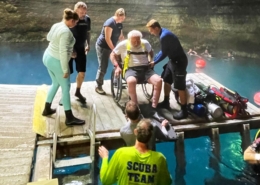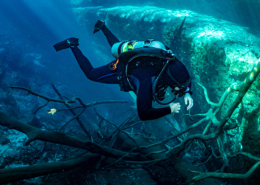Drysuit Myths and Reality
By Tatyana Nikitina
Do you like your dry suit as much as I do? My love is not unfounded. Here are a few reasons I love dry suit diving:
- It protects me from the cold water
- I could put on the layered undergarment and the heated vest
- It`s beautiful and fits me
- It`s convenient – all valves are located where they should be
- It`s easy to wear and easy to take off
- It’s amazing
I personally, chose my dry suit exclusively by brand name (there is a small brand dependence) and size. That’s it! And this leads me to:
Myth 1: Drysuits are hard to choose
Diver in a trilaminate dry suit. The Round Lake, Russia, May 2018. Photo from the Diving for Everybody club archive.
I feel this is untrue. Yes, there are a large number of dry suit manufacturers. There are many brands in the USA, Europe and Russia. You’ll need to narrow your search by putting in some research before buying. First, ask yourself a few questions:
- What material do you want? Trilaminate, bilaminate, Kevlar or neoprene? Talk to your instructor, read about these fabrics, learn how they work and the purposes for which they were created.
- Consider your height, weight, the length of your arms and legs, and shoe size. Do they match the stock sizes offered by manufacturers? If the answer is yes, you won’t necessarily need a custom suit. However, if you need a custom fit, it is better to have your suit made to order.
- What price are you willing to pay for your new dry suit? Keep in mind that while a standard neoprene dry suit is likely the least expensive option, a custom suit will be more expensive.
The most important thing is that you feel comfortable in a dry suit. Make sure it doesn’t squeeze you when you’re crouching, turning or just standing.
Myth 2: Drysuit care is very expensive
This myth can be proved wrong through basic maintenance. Before each dive, lubricate the zipper. Follow the instructions on the zipper lubricant. Next, make sure you handle the neck seal and wrist seals with talcum powder or a special dry suit lubricant.
When removing your dry suit, use a water-based lubricant to protect your seals from tearing. Then close the zipper. If diving in salt or contaminated water, rinse the outside of your dry suit with clean, fresh water. Rinse any of the inner surfaces that may have come in contact with salt, such as the neck seal and wrist seals. Do not leave your dry suit in direct sunlight.
Here is how long you can expect you maintenance items to last. Costs will vary depending on where you live; however, nothing on this list should run more than the equivalent of ten US dollars.
- Zipper lubricant: Available in stick form at most dive stores. As an alternative, some divers use beeswax from the grocery store. A 14 g/0.5 oz stick should last up to two years.
- Talcum powder: Depending on where you live, this may be available at dive centers, pharmacies or grocery stores. A 227 g/8 oz container should last up to two years.
- Water-based lubricant: This can be either “personal lubricant” from the pharmacy or special dry suit lubricant from your local dive center. A 113 g/4 oz tube should last a season.
Myth 3: Drysuit repair costs a fortune
Torn wrist seals. Shutterstock photo.
The cost dry suit repairs will depend largely on the severity of the damage. Most divers turn to specialized dry suit repair centers to replace neck and wrist seals. Seals may break due to careless use or wear and oxidation over time.
Divers may also turn to a repair center if their dry suit leaks. The leak may be due to damage to the suit (cut or puncture), worn seams or broken zippers or valves. It can be difficult to find a puncture or leak in a seam. A dedicated dry suit repair center can conduct a leak test to determine exactly where the repair is needed.
The most expensive repairs generally involve replacing the waterproof zipper. In most cases, the damage is due to improper care.
How much do dry suit repairs cost? Again, this will depend on where you live, the make and model suit and other factors. Here are some typical costs in US dollars, including parts and labor:
- Wrist seal replacement: $90
- Neck seal replacement: $110
- Boot and sock replacement: $330
- Waterproof zippers replacement: $360
- Valve replacement (SI-Tech low profile): $130
You can always ask your local dive shop to recommend a repair center. As you can see, it is cheaper to take care of your suit than to repair it.
Myth 4: Drysuit are dangerous
Initial SDI Dry Suit Diver training generally takes place in confined water. Photo from the Diving for Everybody club archive.
A dry suit is an additional air space divers must manage. To do so safely and enjoyably, you need to take the SDI Dry Suit Diver course. The theoretical part of the training includes:
- Advantages and disadvantages of dry suits
- The variety of models and materials
- Care and minor repairs
The course generally begins in confined water, where students practice buoyancy control and emergency situations. This includes what to do if you become inverted due to air trapped in the legs.
Following this, students apply what they have learned in open water. Successful completion of academic, confined and open-water training means students are ready to begin diving dry without direct instructor supervision. As with most diving activities, however, learning never really stops.
Myth 5: You need to buy a dry suit to take a course
Depending on where and from whom you take your course, you may be required to either supply your own suit or rent one. Suit rental may be included in the price of the course. Conversely, some dive centers include the cost of training in the purchase price of a dry suit.
- The chief benefit of taking the course in a suit you own is that you will learn and become accustomed to using the same suit you will dive after the course.
- On the other hand, during the course, you will learn about different types of suits, their features and how to care for them. This may allow you to make a more informed decision when deciding which suit to buy. Additionally, you may not be ready to buy a dry suit right away. Don’t worry, you can usually rent one.
These may not be all the myths that exist about dry suits, but they are among the most common. Of course, you can learn more about dry suits and acquire the necessary skills by signing up for the SDI Dry Suit Diver Course.













Deixe uma resposta
Want to join the discussion?Feel free to contribute!